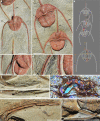Collective behaviour in 480-million-year-old trilobite arthropods from Morocco
- PMID: 31624280
- PMCID: PMC6797724
- DOI: 10.1038/s41598-019-51012-3
Collective behaviour in 480-million-year-old trilobite arthropods from Morocco
Erratum in
-
Author Correction: Collective behaviour in 480-million-year-old trilobite arthropods from Morocco.Sci Rep. 2020 Jan 30;10(1):1842. doi: 10.1038/s41598-020-58756-3. Sci Rep. 2020. PMID: 31996748 Free PMC article.
Abstract
Interactions and coordination between conspecific individuals have produced a remarkable variety of collective behaviours. This co-operation occurs in vertebrate and invertebrate animals and is well expressed in the group flight of birds, fish shoals and highly organized activities of social insects. How individuals interact and why they co-operate to constitute group-level patterns has been extensively studied in extant animals through a variety mechanistic, functional and theoretical approaches. Although collective and social behaviour evolved through natural selection over millions of years, its origin and early history has remained largely unknown. In-situ monospecific linear clusters of trilobite arthropods from the lower Ordovician (ca 480 Ma) of Morocco are interpreted here as resulting either from a collective behaviour triggered by hydrodynamic cues in which mechanical stimulation detected by motion and touch sensors may have played a major role, or from a possible seasonal reproduction behaviour leading to the migration of sexually mature conspecifics to spawning grounds, possibly driven by chemical attraction (e.g. pheromones). This study confirms that collective behaviour has a very ancient origin and probably developed throughout the Cambrian-Ordovician interval, at the same time as the first animal radiation events.
Conflict of interest statement
The authors declare no competing interests.
Figures





References
-
- Sumpter, D. J. T. Collective animal behaviour. Princeton University Press, 312 p (2010).
-
- Steedman, A. Locust handbook. Overseas Development Natural Resources Administration (Great Britain), 204 p (1990).
Publication types
MeSH terms
LinkOut - more resources
Full Text Sources

